Human Resource Management Essay: Absence and Motivation
VerifiedAdded on 2022/11/23
|13
|3830
|2
Essay
AI Summary
This essay delves into the critical aspects of Human Resource Management, focusing on employee absenteeism and motivation. The first part of the essay explores the causes of high employee absence rates, such as burnout, workplace harassment, disengagement, unhealthy working conditions, and inadequate policies. It then outlines proactive strategies for managing absenteeism, including workplace surveys, flexible work schedules, employee engagement programs, and wellness initiatives. The second part of the essay examines three motivation process theories: reinforcement theory, expectancy theory, and equity theory, discussing their role in the workplace. The essay emphasizes how these theories can be applied to enhance employee performance and job satisfaction, ultimately contributing to organizational success. The essay concludes by summarizing the key points and reiterating the importance of addressing employee absence and implementing effective motivational strategies to foster a productive and positive work environment.
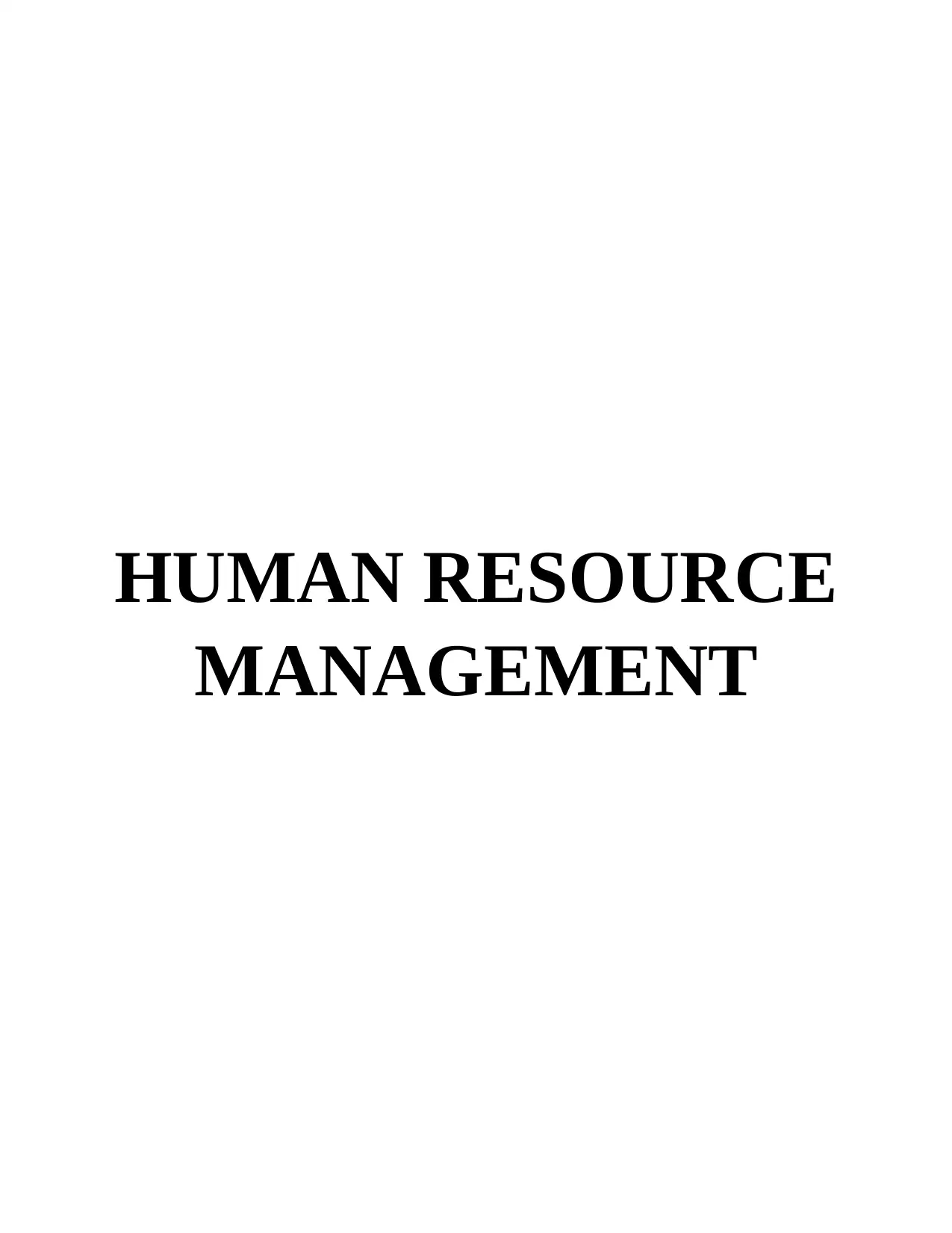
HUMAN RESOURCE
MANAGEMENT
MANAGEMENT
Paraphrase This Document
Need a fresh take? Get an instant paraphrase of this document with our AI Paraphraser
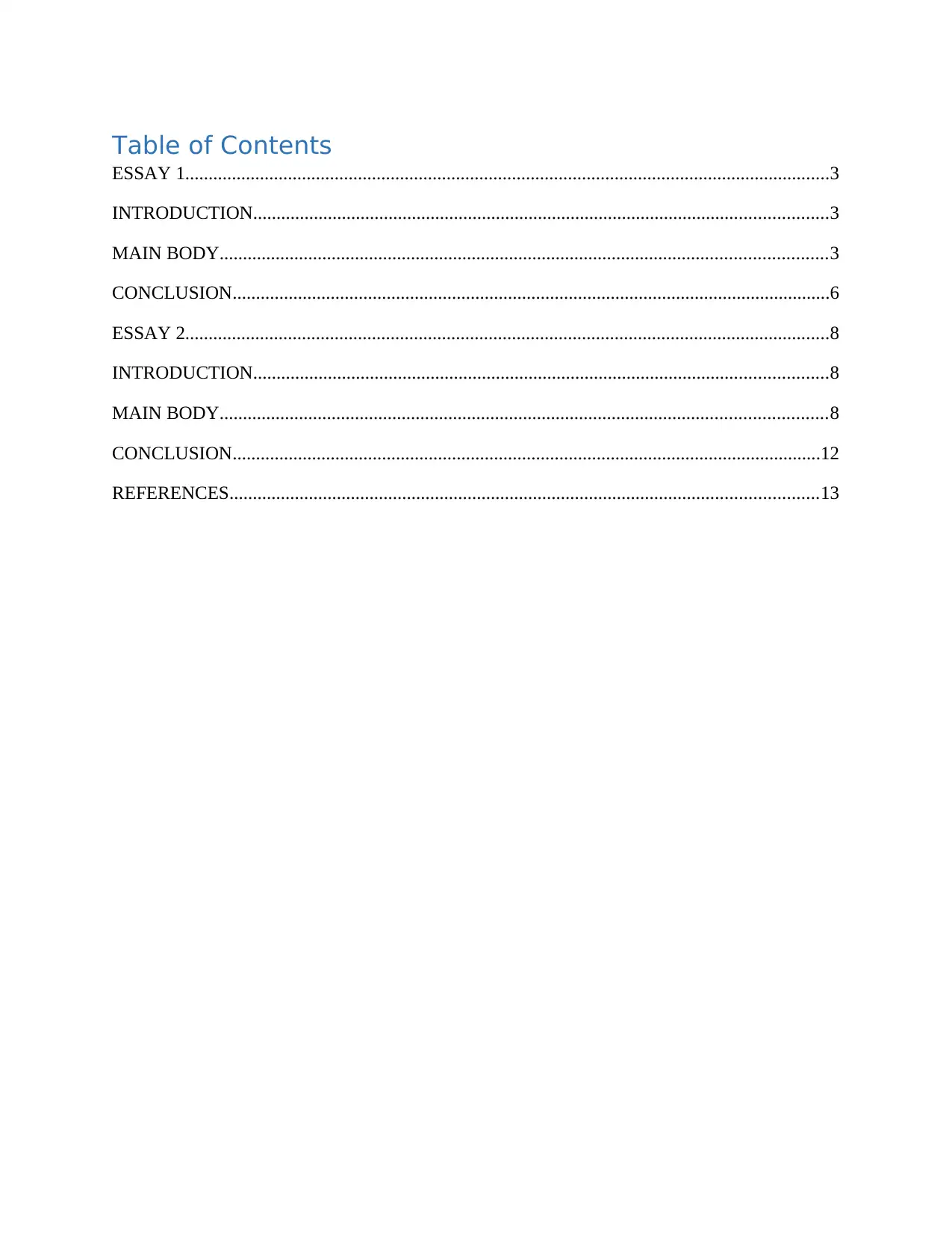
Table of Contents
ESSAY 1..........................................................................................................................................3
INTRODUCTION...........................................................................................................................3
MAIN BODY..................................................................................................................................3
CONCLUSION................................................................................................................................6
ESSAY 2..........................................................................................................................................8
INTRODUCTION...........................................................................................................................8
MAIN BODY..................................................................................................................................8
CONCLUSION..............................................................................................................................12
REFERENCES..............................................................................................................................13
ESSAY 1..........................................................................................................................................3
INTRODUCTION...........................................................................................................................3
MAIN BODY..................................................................................................................................3
CONCLUSION................................................................................................................................6
ESSAY 2..........................................................................................................................................8
INTRODUCTION...........................................................................................................................8
MAIN BODY..................................................................................................................................8
CONCLUSION..............................................................................................................................12
REFERENCES..............................................................................................................................13
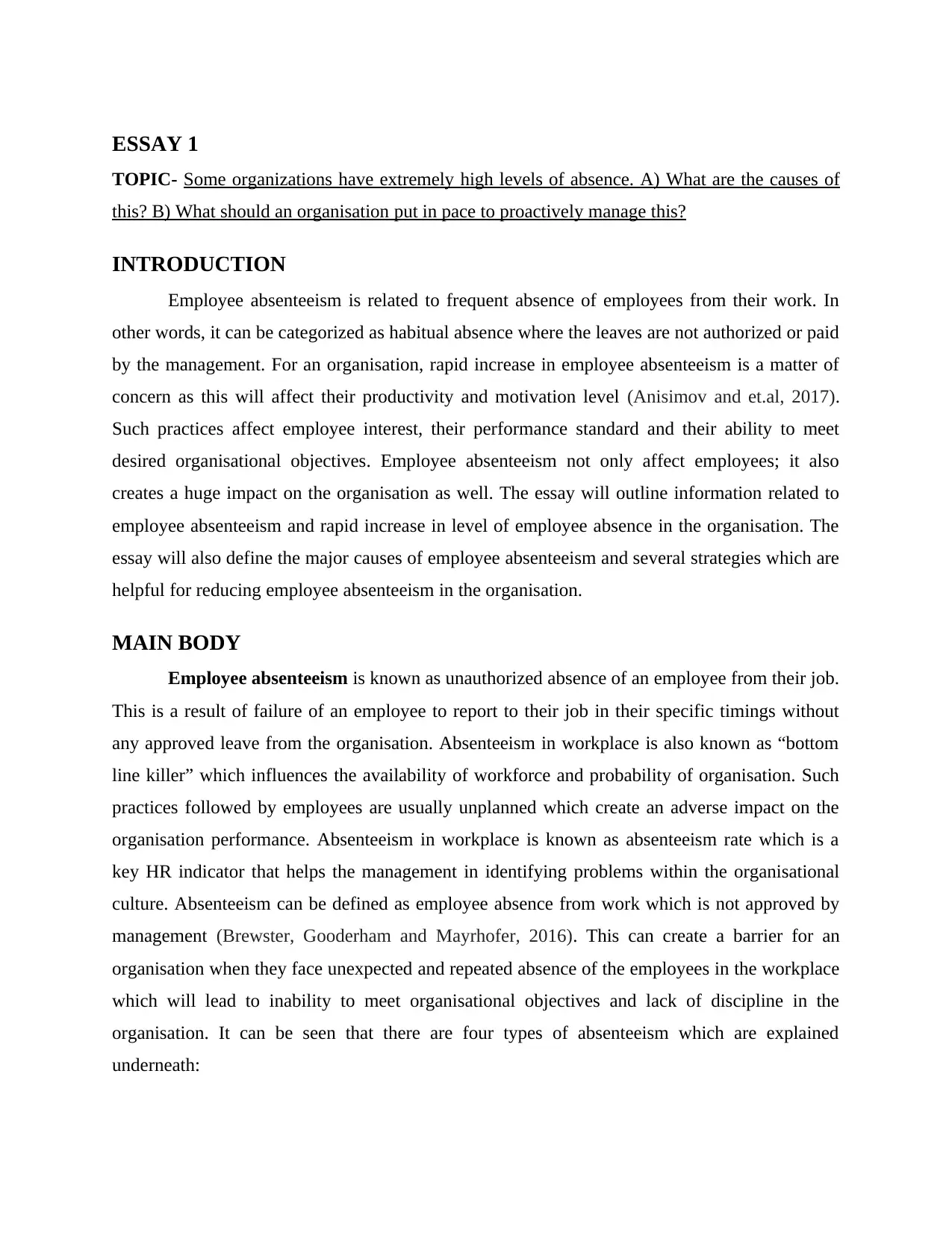
ESSAY 1
TOPIC- Some organizations have extremely high levels of absence. A) What are the causes of
this? B) What should an organisation put in pace to proactively manage this?
INTRODUCTION
Employee absenteeism is related to frequent absence of employees from their work. In
other words, it can be categorized as habitual absence where the leaves are not authorized or paid
by the management. For an organisation, rapid increase in employee absenteeism is a matter of
concern as this will affect their productivity and motivation level (Anisimov and et.al, 2017).
Such practices affect employee interest, their performance standard and their ability to meet
desired organisational objectives. Employee absenteeism not only affect employees; it also
creates a huge impact on the organisation as well. The essay will outline information related to
employee absenteeism and rapid increase in level of employee absence in the organisation. The
essay will also define the major causes of employee absenteeism and several strategies which are
helpful for reducing employee absenteeism in the organisation.
MAIN BODY
Employee absenteeism is known as unauthorized absence of an employee from their job.
This is a result of failure of an employee to report to their job in their specific timings without
any approved leave from the organisation. Absenteeism in workplace is also known as “bottom
line killer” which influences the availability of workforce and probability of organisation. Such
practices followed by employees are usually unplanned which create an adverse impact on the
organisation performance. Absenteeism in workplace is known as absenteeism rate which is a
key HR indicator that helps the management in identifying problems within the organisational
culture. Absenteeism can be defined as employee absence from work which is not approved by
management (Brewster, Gooderham and Mayrhofer, 2016). This can create a barrier for an
organisation when they face unexpected and repeated absence of the employees in the workplace
which will lead to inability to meet organisational objectives and lack of discipline in the
organisation. It can be seen that there are four types of absenteeism which are explained
underneath:
TOPIC- Some organizations have extremely high levels of absence. A) What are the causes of
this? B) What should an organisation put in pace to proactively manage this?
INTRODUCTION
Employee absenteeism is related to frequent absence of employees from their work. In
other words, it can be categorized as habitual absence where the leaves are not authorized or paid
by the management. For an organisation, rapid increase in employee absenteeism is a matter of
concern as this will affect their productivity and motivation level (Anisimov and et.al, 2017).
Such practices affect employee interest, their performance standard and their ability to meet
desired organisational objectives. Employee absenteeism not only affect employees; it also
creates a huge impact on the organisation as well. The essay will outline information related to
employee absenteeism and rapid increase in level of employee absence in the organisation. The
essay will also define the major causes of employee absenteeism and several strategies which are
helpful for reducing employee absenteeism in the organisation.
MAIN BODY
Employee absenteeism is known as unauthorized absence of an employee from their job.
This is a result of failure of an employee to report to their job in their specific timings without
any approved leave from the organisation. Absenteeism in workplace is also known as “bottom
line killer” which influences the availability of workforce and probability of organisation. Such
practices followed by employees are usually unplanned which create an adverse impact on the
organisation performance. Absenteeism in workplace is known as absenteeism rate which is a
key HR indicator that helps the management in identifying problems within the organisational
culture. Absenteeism can be defined as employee absence from work which is not approved by
management (Brewster, Gooderham and Mayrhofer, 2016). This can create a barrier for an
organisation when they face unexpected and repeated absence of the employees in the workplace
which will lead to inability to meet organisational objectives and lack of discipline in the
organisation. It can be seen that there are four types of absenteeism which are explained
underneath:
⊘ This is a preview!⊘
Do you want full access?
Subscribe today to unlock all pages.

Trusted by 1+ million students worldwide
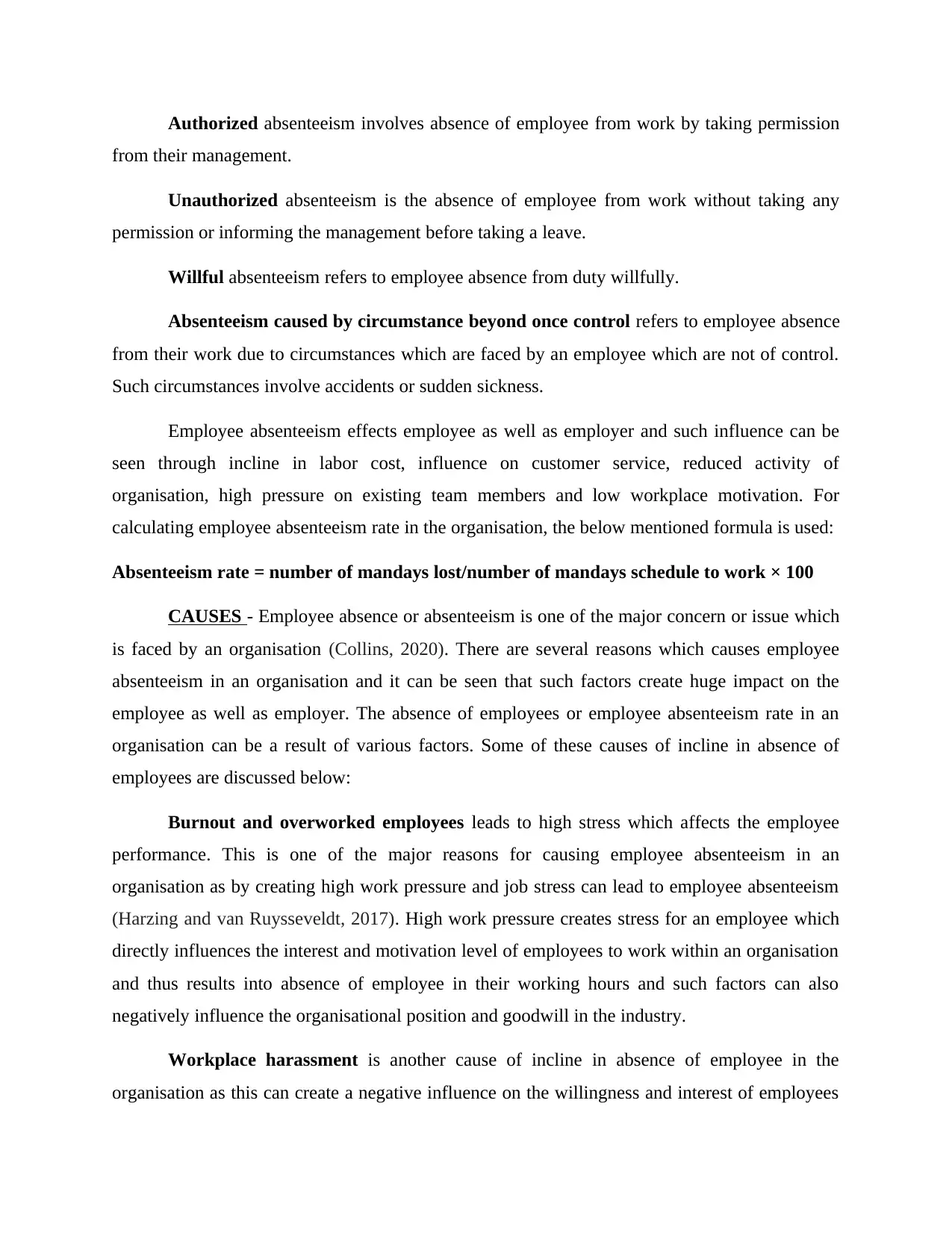
Authorized absenteeism involves absence of employee from work by taking permission
from their management.
Unauthorized absenteeism is the absence of employee from work without taking any
permission or informing the management before taking a leave.
Willful absenteeism refers to employee absence from duty willfully.
Absenteeism caused by circumstance beyond once control refers to employee absence
from their work due to circumstances which are faced by an employee which are not of control.
Such circumstances involve accidents or sudden sickness.
Employee absenteeism effects employee as well as employer and such influence can be
seen through incline in labor cost, influence on customer service, reduced activity of
organisation, high pressure on existing team members and low workplace motivation. For
calculating employee absenteeism rate in the organisation, the below mentioned formula is used:
Absenteeism rate = number of mandays lost/number of mandays schedule to work × 100
CAUSES - Employee absence or absenteeism is one of the major concern or issue which
is faced by an organisation (Collins, 2020). There are several reasons which causes employee
absenteeism in an organisation and it can be seen that such factors create huge impact on the
employee as well as employer. The absence of employees or employee absenteeism rate in an
organisation can be a result of various factors. Some of these causes of incline in absence of
employees are discussed below:
Burnout and overworked employees leads to high stress which affects the employee
performance. This is one of the major reasons for causing employee absenteeism in an
organisation as by creating high work pressure and job stress can lead to employee absenteeism
(Harzing and van Ruysseveldt, 2017). High work pressure creates stress for an employee which
directly influences the interest and motivation level of employees to work within an organisation
and thus results into absence of employee in their working hours and such factors can also
negatively influence the organisational position and goodwill in the industry.
Workplace harassment is another cause of incline in absence of employee in the
organisation as this can create a negative influence on the willingness and interest of employees
from their management.
Unauthorized absenteeism is the absence of employee from work without taking any
permission or informing the management before taking a leave.
Willful absenteeism refers to employee absence from duty willfully.
Absenteeism caused by circumstance beyond once control refers to employee absence
from their work due to circumstances which are faced by an employee which are not of control.
Such circumstances involve accidents or sudden sickness.
Employee absenteeism effects employee as well as employer and such influence can be
seen through incline in labor cost, influence on customer service, reduced activity of
organisation, high pressure on existing team members and low workplace motivation. For
calculating employee absenteeism rate in the organisation, the below mentioned formula is used:
Absenteeism rate = number of mandays lost/number of mandays schedule to work × 100
CAUSES - Employee absence or absenteeism is one of the major concern or issue which
is faced by an organisation (Collins, 2020). There are several reasons which causes employee
absenteeism in an organisation and it can be seen that such factors create huge impact on the
employee as well as employer. The absence of employees or employee absenteeism rate in an
organisation can be a result of various factors. Some of these causes of incline in absence of
employees are discussed below:
Burnout and overworked employees leads to high stress which affects the employee
performance. This is one of the major reasons for causing employee absenteeism in an
organisation as by creating high work pressure and job stress can lead to employee absenteeism
(Harzing and van Ruysseveldt, 2017). High work pressure creates stress for an employee which
directly influences the interest and motivation level of employees to work within an organisation
and thus results into absence of employee in their working hours and such factors can also
negatively influence the organisational position and goodwill in the industry.
Workplace harassment is another cause of incline in absence of employee in the
organisation as this can create a negative influence on the willingness and interest of employees
Paraphrase This Document
Need a fresh take? Get an instant paraphrase of this document with our AI Paraphraser

which leads to unauthorized leave. Workplace harassment or misbehavior in the organisation can
adversely affect the interest and willingness of an employee as this can be the major factors
which affects the employee physically as well as mentally.
Disengagement is an outcome of lack of passion of employees in workplace and lack of
interest for their job which is one of the major factor for increasing employee absenteeism in the
organisation (Liu, Qingqing and Liu, 2021). Lack of interest or passion is one of the major factor
which drive moral of employees and due to lack of such factors can cause lack of interest which
will ultimately lead to increase in employee absenteeism.
Unhealthy working conditions are another cause of employee absenteeism in the
organisation as this affects the motivation level of employees. Due to unfavorable conditions and
negative organisational culture is responsible for incline in absence of employees in the
workplace. Unhealthy working conditions such as negative communication or healthy
relationship between employer and employee affects the productivity of employees which
creates a negative influence and leads to absence of employees without any approved leave. Poor
working conditions and lack of fulfillment of basic requirements is a cause of employee absence
in the organisation.
Lack of employee welfare programs and plans leads to less employee centric
organisation which is responsible for incline in uninterested employee in the business and such
factors are responsible for lack of productivity in the organisation and incline in the rate of
absenteeism of employees (Lorincová and et.al, 2018). Poor appraisal policy, lack of recognition
for the performance of employees, this can lead to demotivated organisational culture as
employee will feel their performance is not valued by the organisation which will result into
employee absence without any unauthorized or approved leave by the management.
Inadequate leave policy is another cause of absence of employee as lack of paid and
casual leaves offered by the company this effects the interest and motivation level of employees
which leads to incline in employee absence.
STRATEGIES FOR MANAGING EMPLOYEE ABSENCE - For proactively
managing and reducing the employee absenteeism in the organisation, there are several strategies
adversely affect the interest and willingness of an employee as this can be the major factors
which affects the employee physically as well as mentally.
Disengagement is an outcome of lack of passion of employees in workplace and lack of
interest for their job which is one of the major factor for increasing employee absenteeism in the
organisation (Liu, Qingqing and Liu, 2021). Lack of interest or passion is one of the major factor
which drive moral of employees and due to lack of such factors can cause lack of interest which
will ultimately lead to increase in employee absenteeism.
Unhealthy working conditions are another cause of employee absenteeism in the
organisation as this affects the motivation level of employees. Due to unfavorable conditions and
negative organisational culture is responsible for incline in absence of employees in the
workplace. Unhealthy working conditions such as negative communication or healthy
relationship between employer and employee affects the productivity of employees which
creates a negative influence and leads to absence of employees without any approved leave. Poor
working conditions and lack of fulfillment of basic requirements is a cause of employee absence
in the organisation.
Lack of employee welfare programs and plans leads to less employee centric
organisation which is responsible for incline in uninterested employee in the business and such
factors are responsible for lack of productivity in the organisation and incline in the rate of
absenteeism of employees (Lorincová and et.al, 2018). Poor appraisal policy, lack of recognition
for the performance of employees, this can lead to demotivated organisational culture as
employee will feel their performance is not valued by the organisation which will result into
employee absence without any unauthorized or approved leave by the management.
Inadequate leave policy is another cause of absence of employee as lack of paid and
casual leaves offered by the company this effects the interest and motivation level of employees
which leads to incline in employee absence.
STRATEGIES FOR MANAGING EMPLOYEE ABSENCE - For proactively
managing and reducing the employee absenteeism in the organisation, there are several strategies

which can be followed by the organisation. Some of the strategies for managing the employee
absenteeism in the organisation are listed below:
Workplace survey and employee opinion will be a helpful strategy for solving issues
and progressing towards a solution for such conflicts (Meijerink and Keegan, 2019). By
regularly communicating with employees, understanding and asking them regarding the issues
which are faced by employees in the workplace, identifying any ongoing medication or health
issue faced by the employees or by focusing on providing maximum job satisfaction will be
helpful for understanding employee opinion and reducing employee absence or absenteeism in
the organisation.
By adopting a flexible work schedule is one of the easiest approach for managing
employee absence in modern day workplace. Such strategy will be helpful in connecting with
employees, ensuring employee commitment towards organisation, creating better work life
balance, enhancing their performance and leading to organisational productivity.
Employee engagement programs will be a helpful strategy for an organisation to keep
their employees motivated and engaged in the organisation and it also helps in bridging the gap
between employee as well as employee which brings various advantages. By acknowledging
employee effort and performance and appreciating will be helpful in reducing absenteeism in the
workplace.
Employee wellness programs is another helpful strategy as due to rapid increase in the
work pressure or stress on employees, this creates many health issues which can affect the
presence of employees at work (Ng and Parry, 2016). Employee wellness program will be a
helpful strategy to encourage employees to stay fit and healthy and such programs will act as
motivation drivers for employees to regularly engage in managerial activities and reduce
employee absenteeism and turnover.
Rewards and incentives are a medium which helps in boosting employee morale at
workplace. By recognizing, rewarding, offering incentives and offering paid vacations to
employees for their valuable contribution and effective performance in the organisation will be
and helpful strategy for keeping employees motivated and such strategy will be helpful in
minimizing employee turnover and absenteeism in the workplace.
absenteeism in the organisation are listed below:
Workplace survey and employee opinion will be a helpful strategy for solving issues
and progressing towards a solution for such conflicts (Meijerink and Keegan, 2019). By
regularly communicating with employees, understanding and asking them regarding the issues
which are faced by employees in the workplace, identifying any ongoing medication or health
issue faced by the employees or by focusing on providing maximum job satisfaction will be
helpful for understanding employee opinion and reducing employee absence or absenteeism in
the organisation.
By adopting a flexible work schedule is one of the easiest approach for managing
employee absence in modern day workplace. Such strategy will be helpful in connecting with
employees, ensuring employee commitment towards organisation, creating better work life
balance, enhancing their performance and leading to organisational productivity.
Employee engagement programs will be a helpful strategy for an organisation to keep
their employees motivated and engaged in the organisation and it also helps in bridging the gap
between employee as well as employee which brings various advantages. By acknowledging
employee effort and performance and appreciating will be helpful in reducing absenteeism in the
workplace.
Employee wellness programs is another helpful strategy as due to rapid increase in the
work pressure or stress on employees, this creates many health issues which can affect the
presence of employees at work (Ng and Parry, 2016). Employee wellness program will be a
helpful strategy to encourage employees to stay fit and healthy and such programs will act as
motivation drivers for employees to regularly engage in managerial activities and reduce
employee absenteeism and turnover.
Rewards and incentives are a medium which helps in boosting employee morale at
workplace. By recognizing, rewarding, offering incentives and offering paid vacations to
employees for their valuable contribution and effective performance in the organisation will be
and helpful strategy for keeping employees motivated and such strategy will be helpful in
minimizing employee turnover and absenteeism in the workplace.
⊘ This is a preview!⊘
Do you want full access?
Subscribe today to unlock all pages.

Trusted by 1+ million students worldwide
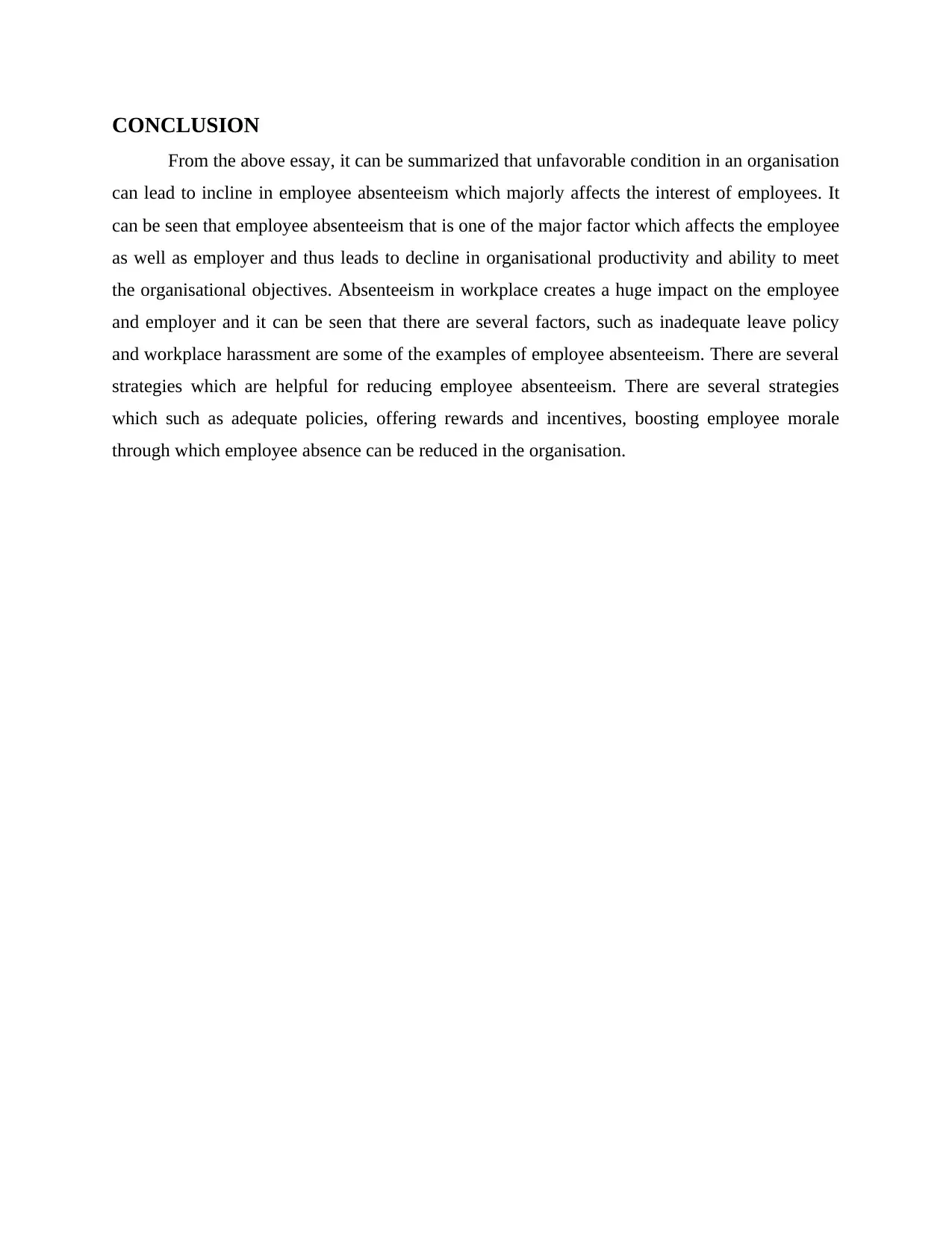
CONCLUSION
From the above essay, it can be summarized that unfavorable condition in an organisation
can lead to incline in employee absenteeism which majorly affects the interest of employees. It
can be seen that employee absenteeism that is one of the major factor which affects the employee
as well as employer and thus leads to decline in organisational productivity and ability to meet
the organisational objectives. Absenteeism in workplace creates a huge impact on the employee
and employer and it can be seen that there are several factors, such as inadequate leave policy
and workplace harassment are some of the examples of employee absenteeism. There are several
strategies which are helpful for reducing employee absenteeism. There are several strategies
which such as adequate policies, offering rewards and incentives, boosting employee morale
through which employee absence can be reduced in the organisation.
From the above essay, it can be summarized that unfavorable condition in an organisation
can lead to incline in employee absenteeism which majorly affects the interest of employees. It
can be seen that employee absenteeism that is one of the major factor which affects the employee
as well as employer and thus leads to decline in organisational productivity and ability to meet
the organisational objectives. Absenteeism in workplace creates a huge impact on the employee
and employer and it can be seen that there are several factors, such as inadequate leave policy
and workplace harassment are some of the examples of employee absenteeism. There are several
strategies which are helpful for reducing employee absenteeism. There are several strategies
which such as adequate policies, offering rewards and incentives, boosting employee morale
through which employee absence can be reduced in the organisation.
Paraphrase This Document
Need a fresh take? Get an instant paraphrase of this document with our AI Paraphraser
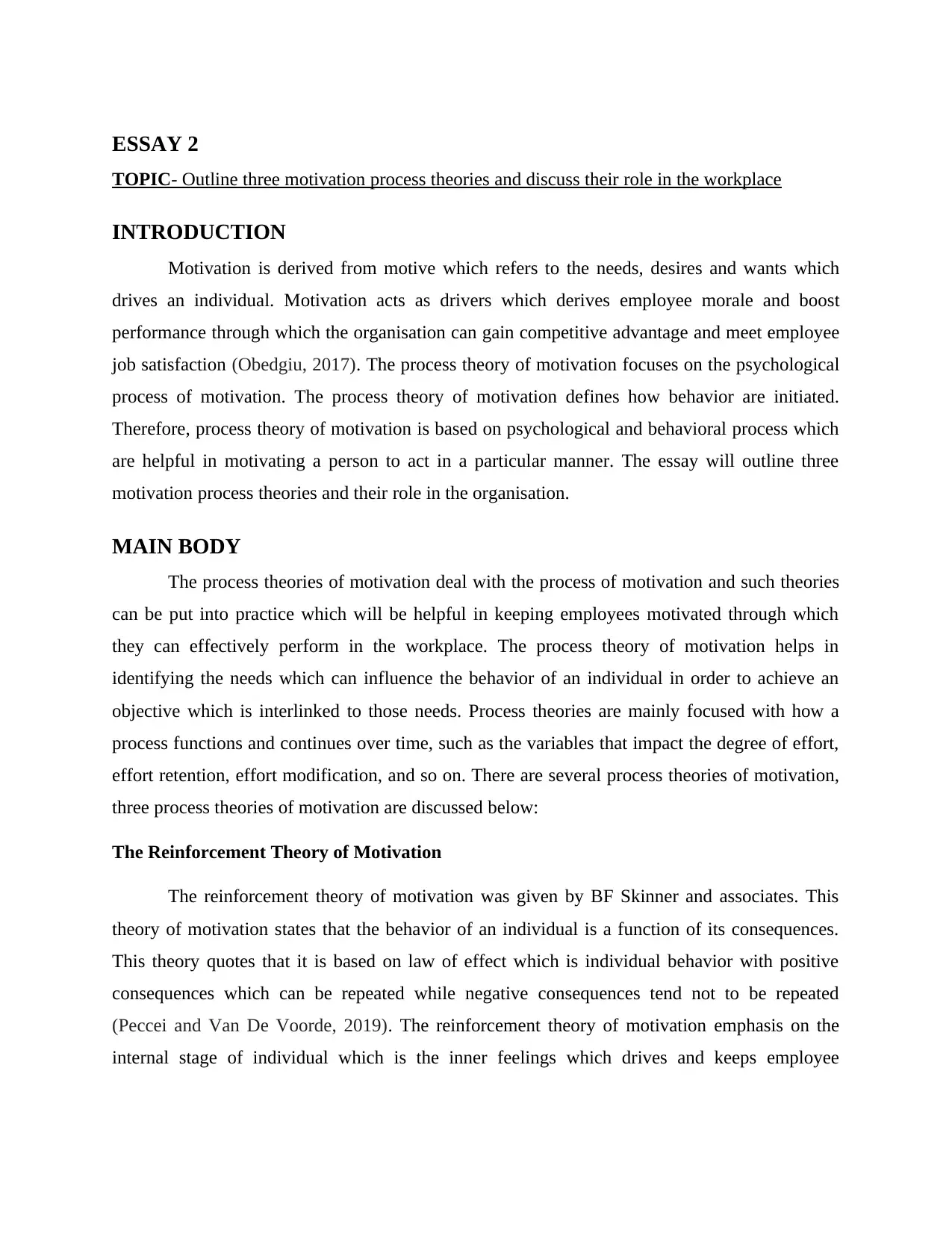
ESSAY 2
TOPIC- Outline three motivation process theories and discuss their role in the workplace
INTRODUCTION
Motivation is derived from motive which refers to the needs, desires and wants which
drives an individual. Motivation acts as drivers which derives employee morale and boost
performance through which the organisation can gain competitive advantage and meet employee
job satisfaction (Obedgiu, 2017). The process theory of motivation focuses on the psychological
process of motivation. The process theory of motivation defines how behavior are initiated.
Therefore, process theory of motivation is based on psychological and behavioral process which
are helpful in motivating a person to act in a particular manner. The essay will outline three
motivation process theories and their role in the organisation.
MAIN BODY
The process theories of motivation deal with the process of motivation and such theories
can be put into practice which will be helpful in keeping employees motivated through which
they can effectively perform in the workplace. The process theory of motivation helps in
identifying the needs which can influence the behavior of an individual in order to achieve an
objective which is interlinked to those needs. Process theories are mainly focused with how a
process functions and continues over time, such as the variables that impact the degree of effort,
effort retention, effort modification, and so on. There are several process theories of motivation,
three process theories of motivation are discussed below:
The Reinforcement Theory of Motivation
The reinforcement theory of motivation was given by BF Skinner and associates. This
theory of motivation states that the behavior of an individual is a function of its consequences.
This theory quotes that it is based on law of effect which is individual behavior with positive
consequences which can be repeated while negative consequences tend not to be repeated
(Peccei and Van De Voorde, 2019). The reinforcement theory of motivation emphasis on the
internal stage of individual which is the inner feelings which drives and keeps employee
TOPIC- Outline three motivation process theories and discuss their role in the workplace
INTRODUCTION
Motivation is derived from motive which refers to the needs, desires and wants which
drives an individual. Motivation acts as drivers which derives employee morale and boost
performance through which the organisation can gain competitive advantage and meet employee
job satisfaction (Obedgiu, 2017). The process theory of motivation focuses on the psychological
process of motivation. The process theory of motivation defines how behavior are initiated.
Therefore, process theory of motivation is based on psychological and behavioral process which
are helpful in motivating a person to act in a particular manner. The essay will outline three
motivation process theories and their role in the organisation.
MAIN BODY
The process theories of motivation deal with the process of motivation and such theories
can be put into practice which will be helpful in keeping employees motivated through which
they can effectively perform in the workplace. The process theory of motivation helps in
identifying the needs which can influence the behavior of an individual in order to achieve an
objective which is interlinked to those needs. Process theories are mainly focused with how a
process functions and continues over time, such as the variables that impact the degree of effort,
effort retention, effort modification, and so on. There are several process theories of motivation,
three process theories of motivation are discussed below:
The Reinforcement Theory of Motivation
The reinforcement theory of motivation was given by BF Skinner and associates. This
theory of motivation states that the behavior of an individual is a function of its consequences.
This theory quotes that it is based on law of effect which is individual behavior with positive
consequences which can be repeated while negative consequences tend not to be repeated
(Peccei and Van De Voorde, 2019). The reinforcement theory of motivation emphasis on the
internal stage of individual which is the inner feelings which drives and keeps employee

motivated at workplace. The reinforcement theory of motivation explains how an individual
learns behavior.
The reinforcement theory in the workplace supports manager in rewarding, punishing or
ignoring behavior in an effort of employees which will help them to increase their efficiency and
productivity. This employee management approach has both supporters and detractors. The
reinforcement theory of motivation allows leader or management to follow their judgement in
order to maintain the efficiency of their staff which will be helpful in accomplishment of
objectives and organisational position in the industry (Santana and Lopez‐Cabrales, 2019). The
types of reinforcement in the workplace can be classified on the basis of employee behavior
which can be positive, negative, extinction or based on punishment.
Positive reinforcement
Positive reinforcement strategy offers positive
rewards to employees for the performance
and emphasis that rewarded behavior results
into repeated behavior and enhances the level
of achievement and performance level.
Negative reinforcement
Negative reinforcement theory emphasis
organisation behavior focuses on approach in
which employees are punished for their poor
performance which can create negative impact
on employee willingness and their
performance level. Such factors can increase
the stress in workplace, leads to low employee
morale and affect the performance standard.
Extinction
Extinction reinforcement is a strategy where
employees are not praised nor hold
accountable for their work. Such approach
helps in reducing stress at workplace and
helpful for incline in retention. Whereas the
productivity and efficiency of employees are
sacrificed through such strategies.
Punishment
The strategy of reinforcement theory implies
removing positive consequences which will
reduce the probability of repeating undesirable
behavior in near-future. It can be equalized by
positive reinforcement from alternative source
as the strategy focuses on applying in giving
undesirable consequences to employees for
showing unethical or undesirable behavior in
the business.
learns behavior.
The reinforcement theory in the workplace supports manager in rewarding, punishing or
ignoring behavior in an effort of employees which will help them to increase their efficiency and
productivity. This employee management approach has both supporters and detractors. The
reinforcement theory of motivation allows leader or management to follow their judgement in
order to maintain the efficiency of their staff which will be helpful in accomplishment of
objectives and organisational position in the industry (Santana and Lopez‐Cabrales, 2019). The
types of reinforcement in the workplace can be classified on the basis of employee behavior
which can be positive, negative, extinction or based on punishment.
Positive reinforcement
Positive reinforcement strategy offers positive
rewards to employees for the performance
and emphasis that rewarded behavior results
into repeated behavior and enhances the level
of achievement and performance level.
Negative reinforcement
Negative reinforcement theory emphasis
organisation behavior focuses on approach in
which employees are punished for their poor
performance which can create negative impact
on employee willingness and their
performance level. Such factors can increase
the stress in workplace, leads to low employee
morale and affect the performance standard.
Extinction
Extinction reinforcement is a strategy where
employees are not praised nor hold
accountable for their work. Such approach
helps in reducing stress at workplace and
helpful for incline in retention. Whereas the
productivity and efficiency of employees are
sacrificed through such strategies.
Punishment
The strategy of reinforcement theory implies
removing positive consequences which will
reduce the probability of repeating undesirable
behavior in near-future. It can be equalized by
positive reinforcement from alternative source
as the strategy focuses on applying in giving
undesirable consequences to employees for
showing unethical or undesirable behavior in
the business.
⊘ This is a preview!⊘
Do you want full access?
Subscribe today to unlock all pages.

Trusted by 1+ million students worldwide
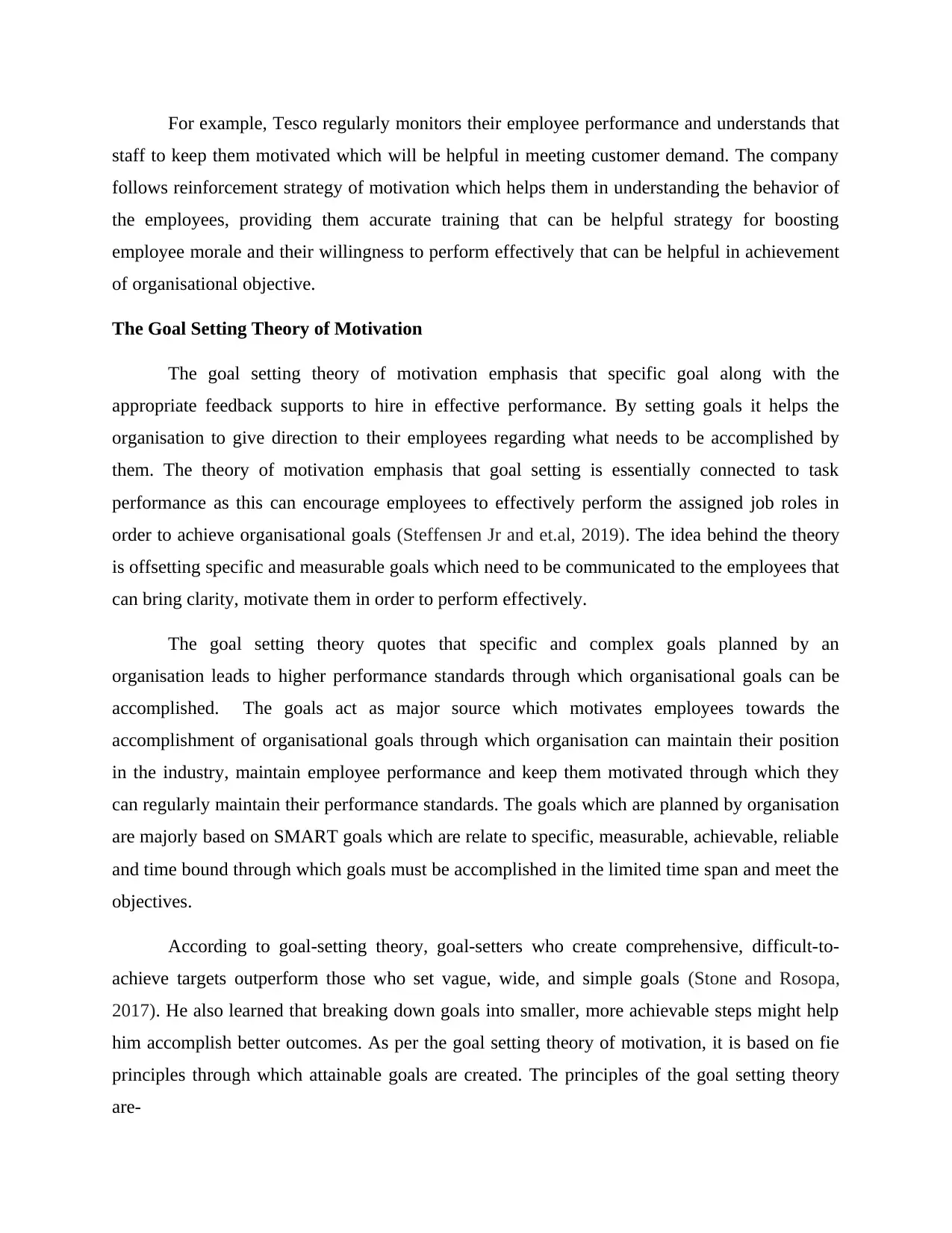
For example, Tesco regularly monitors their employee performance and understands that
staff to keep them motivated which will be helpful in meeting customer demand. The company
follows reinforcement strategy of motivation which helps them in understanding the behavior of
the employees, providing them accurate training that can be helpful strategy for boosting
employee morale and their willingness to perform effectively that can be helpful in achievement
of organisational objective.
The Goal Setting Theory of Motivation
The goal setting theory of motivation emphasis that specific goal along with the
appropriate feedback supports to hire in effective performance. By setting goals it helps the
organisation to give direction to their employees regarding what needs to be accomplished by
them. The theory of motivation emphasis that goal setting is essentially connected to task
performance as this can encourage employees to effectively perform the assigned job roles in
order to achieve organisational goals (Steffensen Jr and et.al, 2019). The idea behind the theory
is offsetting specific and measurable goals which need to be communicated to the employees that
can bring clarity, motivate them in order to perform effectively.
The goal setting theory quotes that specific and complex goals planned by an
organisation leads to higher performance standards through which organisational goals can be
accomplished. The goals act as major source which motivates employees towards the
accomplishment of organisational goals through which organisation can maintain their position
in the industry, maintain employee performance and keep them motivated through which they
can regularly maintain their performance standards. The goals which are planned by organisation
are majorly based on SMART goals which are relate to specific, measurable, achievable, reliable
and time bound through which goals must be accomplished in the limited time span and meet the
objectives.
According to goal-setting theory, goal-setters who create comprehensive, difficult-to-
achieve targets outperform those who set vague, wide, and simple goals (Stone and Rosopa,
2017). He also learned that breaking down goals into smaller, more achievable steps might help
him accomplish better outcomes. As per the goal setting theory of motivation, it is based on fie
principles through which attainable goals are created. The principles of the goal setting theory
are-
staff to keep them motivated which will be helpful in meeting customer demand. The company
follows reinforcement strategy of motivation which helps them in understanding the behavior of
the employees, providing them accurate training that can be helpful strategy for boosting
employee morale and their willingness to perform effectively that can be helpful in achievement
of organisational objective.
The Goal Setting Theory of Motivation
The goal setting theory of motivation emphasis that specific goal along with the
appropriate feedback supports to hire in effective performance. By setting goals it helps the
organisation to give direction to their employees regarding what needs to be accomplished by
them. The theory of motivation emphasis that goal setting is essentially connected to task
performance as this can encourage employees to effectively perform the assigned job roles in
order to achieve organisational goals (Steffensen Jr and et.al, 2019). The idea behind the theory
is offsetting specific and measurable goals which need to be communicated to the employees that
can bring clarity, motivate them in order to perform effectively.
The goal setting theory quotes that specific and complex goals planned by an
organisation leads to higher performance standards through which organisational goals can be
accomplished. The goals act as major source which motivates employees towards the
accomplishment of organisational goals through which organisation can maintain their position
in the industry, maintain employee performance and keep them motivated through which they
can regularly maintain their performance standards. The goals which are planned by organisation
are majorly based on SMART goals which are relate to specific, measurable, achievable, reliable
and time bound through which goals must be accomplished in the limited time span and meet the
objectives.
According to goal-setting theory, goal-setters who create comprehensive, difficult-to-
achieve targets outperform those who set vague, wide, and simple goals (Stone and Rosopa,
2017). He also learned that breaking down goals into smaller, more achievable steps might help
him accomplish better outcomes. As per the goal setting theory of motivation, it is based on fie
principles through which attainable goals are created. The principles of the goal setting theory
are-
Paraphrase This Document
Need a fresh take? Get an instant paraphrase of this document with our AI Paraphraser

Clarity- A precise and measurable objective is more feasible than a goal that is poorly
defined, according to the effective use of motivation theories in business.
Challenge- There must be some amount of challenge to inspire a worker to achieve a
goal.
Commitment- To make a task useful, according to Locke, one must make a conscious
effort to achieve the objective.
Feedback- Receiving feedback on one's progress toward a goal, it turns out, motivates
one to do better.
The complexity of the task- In order to successfully apply motivation theories in
organizations, the goal-setter must evaluate the complexity of the aim ahead of them and make
attempts to decrease it.
For example, Deloitte use goal setting theory of motivation which helps the organisation
in setting goals through which they can enhance employee performance, improve quality of and
contributes in improving the business growth.
The Expectancy Theory of Motivation
The expectancy theory of motivation was proposed by Victor Vroom in the year 1964.
This theory quotes the intensity of a tendency to perform in a particular manner is dependent on
the intensity of an expectation that the performance will be followed by definite outcome and on
the appeal of the outcome to the individual. In other words, theory emphasis that individual will
behave in a certain manner because they are motivated to select specific behavior over other
attitudes which is an outcome of their expectation (Strohmeier, 2020). The base of the theory
depends on the cognitive process of how an individual can analyze and process motivational
elements. The primary objective of expectancy theory is to get best possible outcome in order to
receive maximum performance. In this theory Vroom outlined 3 core variables which explains
the correlation between in effort and performance of an individual such variables are Expectancy
(E), Instrumentality (I) and Valence (V).
Vroom expectancy theory supports organisation in creating interesting, dynamic and
challenging jobs and management must ensure that employees can achieve the desired
defined, according to the effective use of motivation theories in business.
Challenge- There must be some amount of challenge to inspire a worker to achieve a
goal.
Commitment- To make a task useful, according to Locke, one must make a conscious
effort to achieve the objective.
Feedback- Receiving feedback on one's progress toward a goal, it turns out, motivates
one to do better.
The complexity of the task- In order to successfully apply motivation theories in
organizations, the goal-setter must evaluate the complexity of the aim ahead of them and make
attempts to decrease it.
For example, Deloitte use goal setting theory of motivation which helps the organisation
in setting goals through which they can enhance employee performance, improve quality of and
contributes in improving the business growth.
The Expectancy Theory of Motivation
The expectancy theory of motivation was proposed by Victor Vroom in the year 1964.
This theory quotes the intensity of a tendency to perform in a particular manner is dependent on
the intensity of an expectation that the performance will be followed by definite outcome and on
the appeal of the outcome to the individual. In other words, theory emphasis that individual will
behave in a certain manner because they are motivated to select specific behavior over other
attitudes which is an outcome of their expectation (Strohmeier, 2020). The base of the theory
depends on the cognitive process of how an individual can analyze and process motivational
elements. The primary objective of expectancy theory is to get best possible outcome in order to
receive maximum performance. In this theory Vroom outlined 3 core variables which explains
the correlation between in effort and performance of an individual such variables are Expectancy
(E), Instrumentality (I) and Valence (V).
Vroom expectancy theory supports organisation in creating interesting, dynamic and
challenging jobs and management must ensure that employees can achieve the desired
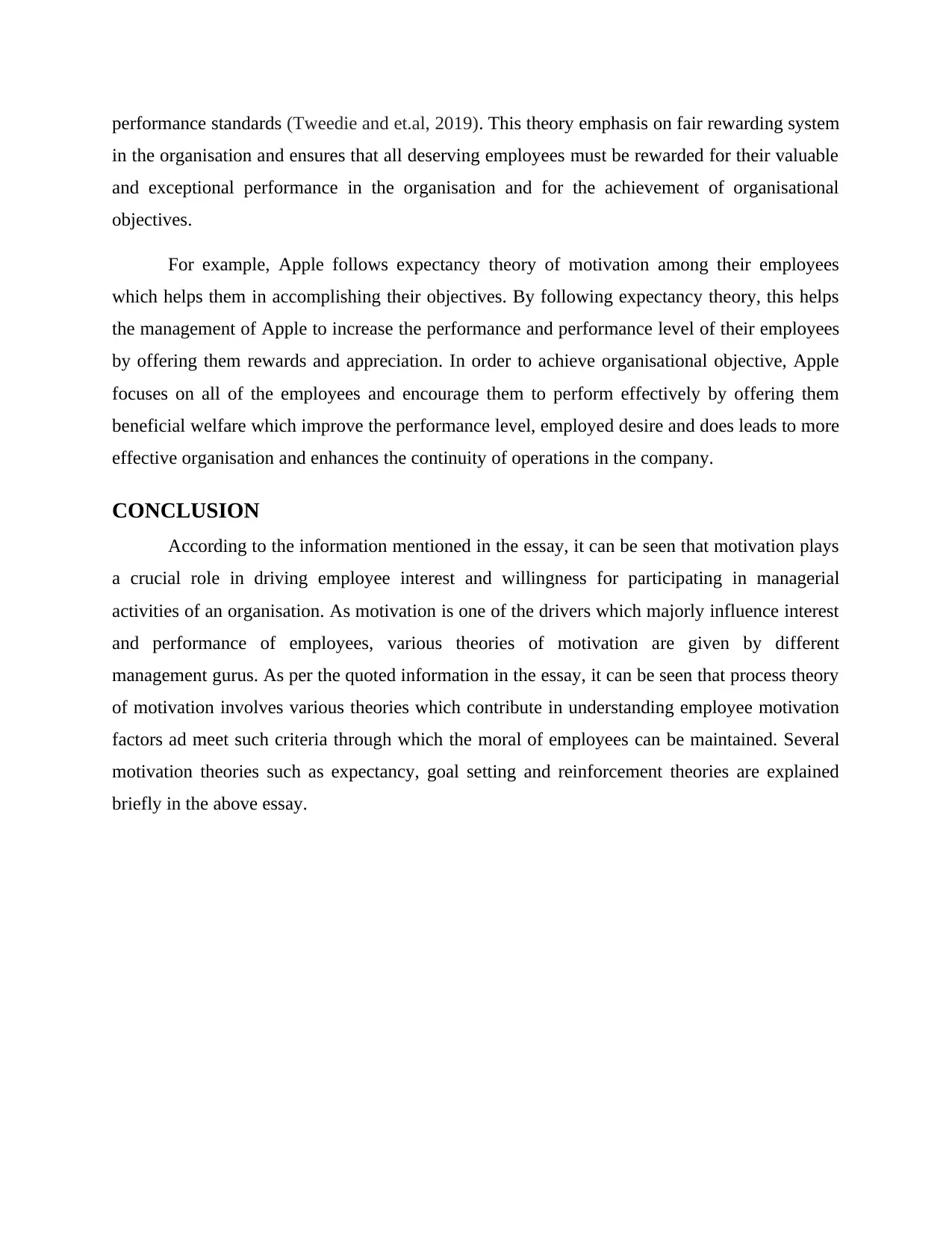
performance standards (Tweedie and et.al, 2019). This theory emphasis on fair rewarding system
in the organisation and ensures that all deserving employees must be rewarded for their valuable
and exceptional performance in the organisation and for the achievement of organisational
objectives.
For example, Apple follows expectancy theory of motivation among their employees
which helps them in accomplishing their objectives. By following expectancy theory, this helps
the management of Apple to increase the performance and performance level of their employees
by offering them rewards and appreciation. In order to achieve organisational objective, Apple
focuses on all of the employees and encourage them to perform effectively by offering them
beneficial welfare which improve the performance level, employed desire and does leads to more
effective organisation and enhances the continuity of operations in the company.
CONCLUSION
According to the information mentioned in the essay, it can be seen that motivation plays
a crucial role in driving employee interest and willingness for participating in managerial
activities of an organisation. As motivation is one of the drivers which majorly influence interest
and performance of employees, various theories of motivation are given by different
management gurus. As per the quoted information in the essay, it can be seen that process theory
of motivation involves various theories which contribute in understanding employee motivation
factors ad meet such criteria through which the moral of employees can be maintained. Several
motivation theories such as expectancy, goal setting and reinforcement theories are explained
briefly in the above essay.
in the organisation and ensures that all deserving employees must be rewarded for their valuable
and exceptional performance in the organisation and for the achievement of organisational
objectives.
For example, Apple follows expectancy theory of motivation among their employees
which helps them in accomplishing their objectives. By following expectancy theory, this helps
the management of Apple to increase the performance and performance level of their employees
by offering them rewards and appreciation. In order to achieve organisational objective, Apple
focuses on all of the employees and encourage them to perform effectively by offering them
beneficial welfare which improve the performance level, employed desire and does leads to more
effective organisation and enhances the continuity of operations in the company.
CONCLUSION
According to the information mentioned in the essay, it can be seen that motivation plays
a crucial role in driving employee interest and willingness for participating in managerial
activities of an organisation. As motivation is one of the drivers which majorly influence interest
and performance of employees, various theories of motivation are given by different
management gurus. As per the quoted information in the essay, it can be seen that process theory
of motivation involves various theories which contribute in understanding employee motivation
factors ad meet such criteria through which the moral of employees can be maintained. Several
motivation theories such as expectancy, goal setting and reinforcement theories are explained
briefly in the above essay.
⊘ This is a preview!⊘
Do you want full access?
Subscribe today to unlock all pages.

Trusted by 1+ million students worldwide
1 out of 13
Related Documents
Your All-in-One AI-Powered Toolkit for Academic Success.
+13062052269
info@desklib.com
Available 24*7 on WhatsApp / Email
![[object Object]](/_next/static/media/star-bottom.7253800d.svg)
Unlock your academic potential
Copyright © 2020–2025 A2Z Services. All Rights Reserved. Developed and managed by ZUCOL.




